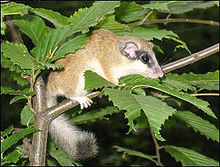- Forest Dormouse
-
For the genus (Dryomys), see Forest dormouse.
Forest Dormouse[1] 
Conservation status Scientific classification Kingdom: Animalia Phylum: Chordata Class: Mammalia Order: Rodentia Family: Gliridae Genus: Dryomys Species: D. nitedula Binomial name Dryomys nitedula
Pallas, 1778The Forest Dormouse (Dryomys nitedula) is a species of rodent in the Gliridae family found in eastern Europe, the Balkans and parts of western Central Asia. It is categorized as being of least concern in the IUCN List of Threatened Species due to its wide range and stable population trend.[2]
Contents
Morphology
The forest dormouse is about 110 millimetres long with a fluffy grey tail nearly as long as its body. The fur on the upper parts of the body is grayish-brown and on the underparts, yellowish-white. There is a black stripe surrounding the eye and extending to the small ear. The whiskers form a bushy tuft about ten millimetres long. There are six pads on each paw.[3]
Distribution and habitat
The range of the forest dormouse is from Switzerland in the west, through central, eastern and southern Europe, the Balkan Peninsula, northward to the Baltic Sea and eastward to the Volga River and the Ural Mountains in Russia.[3] Isolated populations occur outside this range, including in Israel, central Iran, Afghanistan, the Tien Shan mountains and Sinkiang in China.[2] The forest dormouse occurs in a wide range of habitats including broad-leaved, mixed and coniferous woodland. It is also found in rocky areas, dwarf montane woodland, evergreen shrubland and wood-steppe.[2] It is reported as reaching altitudes of up to 3,000 metres.[3]
Biology
This species hibernates and in the northern parts of its range there is only one litter per year but in the southern parts, there are two. The gestation period lasts about four weeks and there are usually four or five young per litter. The young dormice open their eyes in a fortnight and start eating solid food a week later. They leave the nest after about another three weeks and become sexually mature in the following year.[3]
Ecology
When it comes out of hibernation in the spring, the forest dormouse eats buds, shoots and the green parts of plants and also small invertebrates and baby birds. Later in the year, fruit, nuts and seeds predominate. The population does not fluctuate much and the young reared each year only just makes up for those that die during hibernation. Sixty percent of young individuals and the majority of elderly adults (over the age of four) do not survive the winter. Another cause of mortality is storms which may cause the death of juveniles in unprotected nests. Dormice are also predated upon by pine and stone martens, wildcats, owls and crows.
References
- ^ Wilson, Don E.; Reeder, DeeAnn M., eds (2005). Mammal Species of the World (3rd ed.). Baltimore: Johns Hopkins University Press, 2 vols. (2142 pp.). pp. 1768. ISBN 978-0-8018-8221-0. OCLC 62265494. http://www.bucknell.edu/msw3/browse.asp?id=12500027.
- ^ a b c d Amori, G. (1996). "Dryomys nitedula". IUCN Red List of Threatened Species. Version 2007. International Union for Conservation of Nature. http://www.iucnredlist.org/apps/redlist/details/6858. Retrieved 2008-08-14.
- ^ a b c d AgroAtlas
Categories:- IUCN Red List least concern species
- Dryomys
- Animals described in 1778
- Mammals of Afghanistan
- Mammals of Iran
Wikimedia Foundation. 2010.

